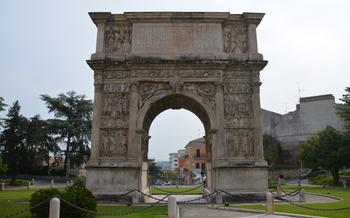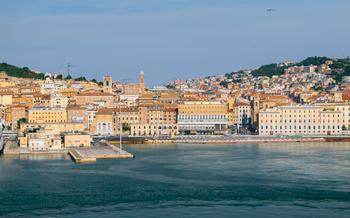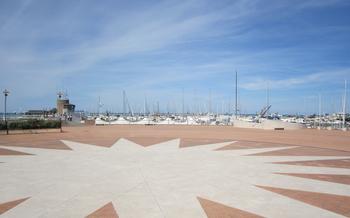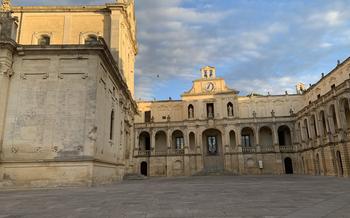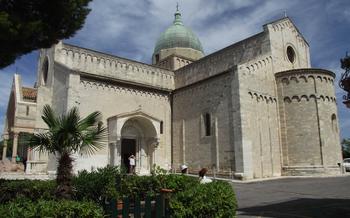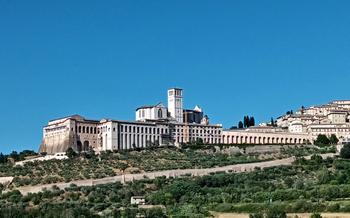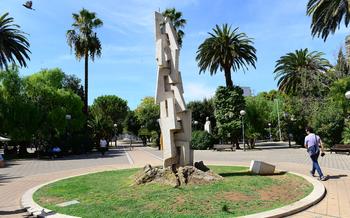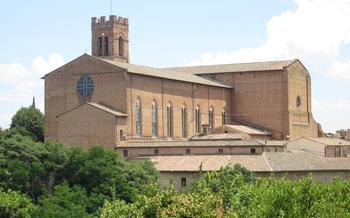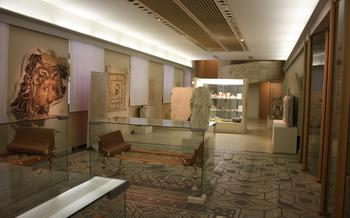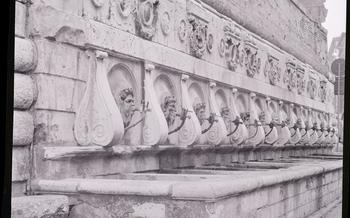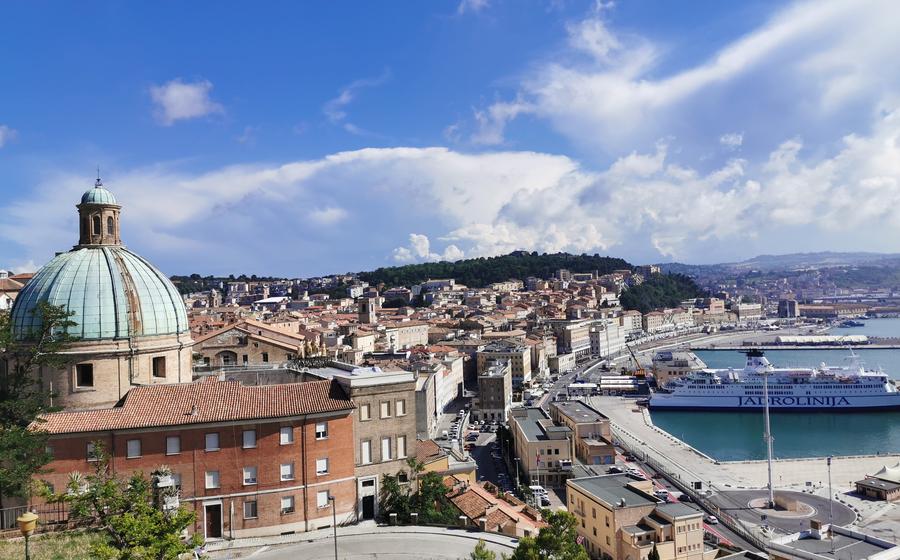
Capuchin Convent of SS. Annunziata
- Introduction
- History and Origins
- Location and Accessibility
- Architectural Design
- Interior Highlights
- Crypt and Ossuary
- Museo Diocesano
- Church of Santa Maria delle Grazie
- Guided Tours and Information
- Photography and Videography
- Dress Code and Etiquette
- Accessibility for Disabled Visitors
- Nearby Attractions
- Local Cuisine and Dining Options
- Insider Tip:
Introduction
In the heart of Ancona, Italy, nestled between the Adriatic Sea and the rolling hills of Le Marche, lies a captivating treasure that beckons curious travelers and history enthusiasts alike. The Capuchin Convent of SS. Annunziata, with its intriguing history, architectural splendor, and macabre crypt, offers a journey through time, spirituality, and the unique traditions of the Capuchin order. Prepare to be awed as we delve into the secrets of this remarkable convent, where the past and the present intertwine, leaving an unforgettable mark on every visitor.
History and Origins
Established in 1548, the Capuchin Convent of SS. Annunziata holds a significant place in Ancona's religious and cultural heritage. Founded by a group of Capuchin friars, this humble monastery grew into a spiritual and intellectual center, attracting devotees and scholars alike. The Capuchin order, known for its austere lifestyle and dedication to poverty, played a crucial role in shaping the convent's distinct character. Their influence is evident in the convent's simple architectural design, devoid of ostentatious decorations, reflecting their commitment to humility and functionality. Over the centuries, the convent has undergone renovations and expansions, preserving its original essence while adapting to the changing needs of the community. Today, it stands as a testament to the enduring legacy of the Capuchin order and offers visitors a glimpse into the fascinating history of Ancona's religious traditions.
Location and Accessibility
The Capuchin Convent of SS. Annunziata is conveniently located in the historic center of Ancona, within easy reach of other landmarks and attractions. Its address is Via Montebello 13, and it is situated near the Piazza Plebiscito, one of the main squares in the city. To reach the convent, visitors can take advantage of Ancona's efficient public transportation system. The bus lines 1, 4, and 12 stop nearby, providing direct connections to various parts of the city. Taxis are also readily available, and there are designated parking areas in the vicinity for those arriving by car.
Architectural Design
The Capuchin Convent of SS. Annunziata stands as a testament to the Capuchin order's architectural prowess. Constructed in the Baroque style, the convent's facade is characterized by its simplicity and elegance. The use of local materials, such as white limestone and travertine, lends a sense of harmony and integration with the surrounding landscape.
Inside the convent, visitors are greeted by a grand staircase, a masterpiece of Baroque architecture. The staircase features intricate carvings and delicate wrought-iron railings, leading to the upper floors of the convent. The cloisters, with their graceful arches and serene atmosphere, provide a peaceful sanctuary for contemplation and reflection.
The refectory, where the Capuchin friars gathered for their meals, is another architectural highlight. The room is adorned with frescoes depicting scenes from the life of St. Francis, the founder of the Capuchin order. The frescoes serve as a reminder of the friars' devotion and their commitment to the ideals of simplicity and humility.
Throughout the convent, visitors can appreciate the Capuchin order's attention to detail and their commitment to creating a space that is both functional and aesthetically pleasing. The architectural design of the Capuchin Convent of SS. Annunziata reflects the order's values and beliefs, creating a harmonious and inspiring environment for its inhabitants.
Interior Highlights
Within the Capuchin Convent of SS. Annunziata, a myriad of captivating features awaits the discerning visitor. The grand staircase, an architectural masterpiece, sweeps upwards, its graceful curves and intricate details a testament to the skill of the Capuchin builders. Its worn steps, smoothed by centuries of footsteps, whisper tales of the friars who ascended and descended, their lives dedicated to devotion and service.
The cloisters, serene and contemplative spaces, provide a refuge from the bustling world outside. Their elegant arches, supported by slender columns, frame tranquil courtyards where the sound of birdsong mingles with the gentle rustle of leaves. In these cloisters, the friars sought solace and communion with the divine, their thoughts turning heavenward amidst the beauty of their surroundings.
The refectory, where the friars gathered for their daily meals, is a testament to the simplicity and functionality that characterized their way of life. Long wooden tables, worn and polished by countless hands, stand in rows, evoking the communal spirit of the Capuchin order. The walls are adorned with frescoes depicting scenes from the lives of saints and martyrs, a reminder of the spiritual sustenance that nourished the friars' souls.
Crypt and Ossuary
Beneath the Capuchin Convent of SS. Annunziata lies a macabre yet fascinating crypt and ossuary, which holds the skeletal remains of hundreds of Capuchin friars who have passed away over the centuries. Arranged in various poses and adorned with their Capuchin robes, these skeletal figures offer a stark reminder of the transient nature of life and the inevitability of death.
This unique display, known as the "crypt of the Capuchins," is a testament to the Capuchin order's belief in the importance of death and the afterlife. For the Capuchins, death was not to be feared, but rather seen as a transition to eternal life.
The crypt is divided into several chambers, each dedicated to a different group of friars. The walls are lined with niches, where the skeletons are arranged in various poses, some standing, others kneeling, and some even engaged in everyday activities such as reading or praying.
Visitors to the crypt will be struck by the sheer number of skeletons, as well as the intricate and detailed arrangements. Some of the skeletons are adorned with their original clothing, while others have been decorated with flowers or other objects.
The crypt is a powerful reminder of the fragility of life and the certainty of death. It is a place where visitors can reflect on their own mortality and the importance of living a meaningful and purposeful life.
Museo Diocesano
Within the confines of the Capuchin Convent lies a treasure trove of religious art and artifacts, known as the Museo Diocesano. This sacred repository houses a diverse collection of paintings, sculptures, and liturgical objects that chronicle the rich history of the Catholic Church in Ancona and the surrounding region. Among its notable highlights are exquisite paintings by renowned Italian masters such as Guercino and Simone Cantarini, whose works adorn the museum's walls. These masterpieces depict biblical scenes and the lives of saints, offering visitors a glimpse into the artistic and spiritual heritage of the region. Sculptures crafted from wood, marble, and bronze grace the museum's collection, showcasing the skill and artistry of local craftsmen. These statues depict religious figures, capturing their expressions and emotions with remarkable detail. Liturgical objects used in religious ceremonies, such as chalices, reliquaries, and vestments, provide insight into the rituals and traditions of the Catholic Church. These ornate pieces often feature intricate designs and precious materials, reflecting the craftsmanship and devotion of their makers.
Church of Santa Maria delle Grazie
Adjacent to the Capuchin Convent stands the elegant Church of Santa Maria delle Grazie, an integral part of the convent complex. This stunning church boasts a rich history, dating back to the 16th century when it was constructed alongside the convent. Its architectural design mirrors the simplicity and functionality embraced by the Capuchin order, featuring a modest yet harmonious facade.
The interior of the church exudes an atmosphere of serenity and spirituality. Visitors are captivated by the intricate artwork adorning the walls and ceiling, depicting religious scenes and the lives of saints. The main altar, a focal point of the church, showcases a beautiful altarpiece that portrays the Virgin Mary with Child.
Throughout the centuries, the Church of Santa Maria delle Grazie has served as a sacred space for the Capuchin friars, a place for prayer, worship, and contemplation. Its serene ambiance and inspiring artworks create a conducive environment for spiritual reflection and connection.
Whether you are a devout pilgrim or simply an admirer of architectural beauty, the Church of Santa Maria delle Grazie is a must-visit destination when exploring the Capuchin Convent of SS. Annunziata.
Guided Tours and Information
To fully appreciate the rich history and significance of the Capuchin Convent, visitors can embark on a guided tour led by knowledgeable guides. These tours offer a deeper insight into the convent's architecture, artwork, and the lives of the Capuchin friars who resided here.
Guided tours are available in various languages and can be booked in advance to secure a spot. Fees for the tours are modest and contribute to the upkeep and preservation of this historical site.
The best time to visit the Capuchin Convent is during the off-season (October to April), when there are fewer crowds and a more intimate atmosphere. Guided tours during this period allow visitors to ask questions and engage in meaningful discussions with the guides.
Whether you're a history buff, an art enthusiast, or simply curious about the Capuchin order, a guided tour of the Capuchin Convent of SS. Annunziata is an experience not to be missed.
Photography and Videography
The Capuchin Convent of SS. Annunziata allows photography and videography for personal use, but certain restrictions apply. Visitors are permitted to capture images of the convent's interior and exterior, but the use of tripods, flash photography, and professional equipment is prohibited. This policy aims to preserve the sacred nature of the site and minimize disruption to other visitors.
When taking photographs or videos, it is essential to be respectful and considerate of the friars and other visitors. Avoid using intrusive equipment or blocking passageways, and always ask permission before photographing or filming individuals. Remember that the convent is an active religious community, and silence and reverence are expected at all times.
For those seeking to capture stunning shots of the convent, the best lighting conditions can be found in the early morning or late afternoon. The warm, golden light of these times casts a beautiful glow on the convent's exterior, highlighting its architectural details. The interior, with its intricate frescoes and sculptures, is best photographed during the day when natural light streams through the windows.
Overall, the Capuchin Convent of SS. Annunziata is a treasure trove of history, art, and spirituality, and photography can be a wonderful way to capture its essence. By following the convent's guidelines and respecting the sanctity of the space, visitors can create beautiful memories of their visit.
Dress Code and Etiquette
Visitors to the Capuchin Convent of SS. Annunziata are expected to dress respectfully, adhering to a dress code that reflects the sacred nature of the site. This means avoiding revealing or excessively casual clothing, and opting for attire that covers shoulders and knees. Shorts, tank tops, and flip-flops are generally not appropriate.
Beyond the dress code, visitors are also expected to maintain a respectful demeanor while exploring the convent. This includes speaking softly, avoiding loud conversations or laughter, and refraining from touching or leaning on any of the exhibits or religious artifacts. Photography is permitted, but visitors should be mindful of others and avoid using flash or tripods.
By following these simple guidelines, visitors can help ensure a peaceful and reverent atmosphere for all who come to experience the beauty and history of the Capuchin Convent of SS. Annunziata.
Accessibility for Disabled Visitors
The Capuchin Convent of SS. Annunziata strives to be accessible and welcoming to visitors of all abilities. Wheelchair users and individuals with limited mobility can easily navigate the convent's main level, which includes the church, the crypt, and the museum. Ramps and elevators have been installed to ensure that these areas are accessible to everyone.
Additionally, the convent offers wheelchairs for temporary use, which can be requested at the entrance. Visitors with disabilities are encouraged to contact the convent in advance to make arrangements for any specific needs or assistance they may require. The staff is committed to providing a positive and inclusive experience for all visitors, ensuring that everyone has the opportunity to explore and appreciate the convent's rich history and cultural significance.
It is important to note that some areas of the convent, such as the upper floors and certain parts of the crypt, may not be easily accessible for wheelchair users due to the historical nature of the building. However, the convent's main attractions, including the church, the crypt, and the museum, are fully accessible, allowing visitors of all abilities to immerse themselves in the convent's unique atmosphere and discover its fascinating stories.
Nearby Attractions
The Capuchin Convent of SS. Annunziata stands as a testament to Ancona's rich history and spiritual heritage. However, the city offers a multitude of other captivating attractions that visitors shouldn't miss.
A short walk from the convent, visitors can marvel at the grandeur of the Ancona Cathedral, a breathtaking example of Romanesque architecture that dominates the city's skyline. The cathedral's majestic facade, intricate stained-glass windows, and awe-inspiring interior are a feast for the eyes.
History buffs will delight in exploring the Arch of Trajan, a triumphal arch erected in the 2nd century AD to commemorate the Roman emperor Trajan's victory over the Dacians. This well-preserved monument stands as a testament to the enduring legacy of the Roman Empire.
For those fascinated by ancient history, the Museo Archeologico Nazionale delle Marche is a must-visit. The museum houses an extensive collection of artifacts from the region's rich past, including prehistoric tools, Greek ceramics, and Roman sculptures. The museum offers a glimpse into the diverse cultures that have shaped Ancona and its surroundings.
These attractions, located within easy reach of the Capuchin Convent, provide visitors with an opportunity to delve deeper into Ancona's cultural tapestry. Whether it's admiring architectural masterpieces, exploring ancient ruins, or delving into the region's history, Ancona offers an array of experiences that complement a visit to the Capuchin Convent.
Local Cuisine and Dining Options
After immersing yourself in the Capuchin Convent's spiritual and architectural wonders, take a culinary journey through Ancona's vibrant food scene. Just a short stroll from the convent, you'll find an array of restaurants and cafes that showcase the region's rich culinary heritage.
For an authentic Italian experience, indulge in a hearty meal at Ristorante Dal Baffo. This family-run establishment serves traditional dishes like pasta alla papera (duck pasta) and succulent grilled meats, accompanied by a carefully curated wine list.
For a quick and delicious bite, head to Panetteria del Porto, a local favorite known for its freshly baked pastries and sandwiches. Sample their delectable focaccia filled with local cheeses and cured meats, or savor their fragrant bread still warm from the oven.
If you're craving seafood, Osteria del Mare is a must-visit. This charming restaurant offers a delightful menu featuring the freshest catches of the day, prepared with simplicity and finesse. Enjoy grilled sea bass with lemon butter sauce or savor a plate of mixed fried seafood, accompanied by a glass of crisp white wine.
No visit to Ancona is complete without trying the local specialty, Brodetto alla Anconetana. This rich fish stew, made with a variety of seafood and tomatoes, is a culinary masterpiece that embodies the essence of the Adriatic coast. Ristorante Brodetto da Adolfo is a renowned spot for this dish, offering a flavorful rendition that will leave you craving more.
To end your meal on a sweet note, head to Gelateria del Corso for a scoop of their artisanal gelato. With a wide variety of flavors to choose from, including traditional favorites like pistachio and hazelnut to unique creations like lavender and rosemary, you're sure to find the perfect treat to satisfy your sweet tooth.
Insider Tip:
For a truly unique and immersive experience, plan your visit to coincide with the annual Festa delle Reliquie, held on the last Sunday of September. During this special celebration, the Capuchin friars display the preserved remains of their deceased brothers, adorned with intricate vestments and floral arrangements. This solemn and moving ceremony offers a glimpse into the Capuchin tradition of venerating their departed members and provides a deeper understanding of their beliefs and customs.
